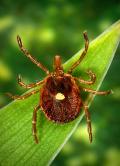Cytauxzoonosis on the “Up-Tick”

You may not have heard of Cytauxzoonosis (pronounced Sight-Oh-zO-un-Osis) before, but if you’re a cat owner, you should definitely pay attention now.
Cytauxzoonosis is a tick-borne, malaria-like illness that, if left untreated, has an almost 100 percent mortality rate in cats. It is caused by the parasite Cytauxzoon felis, found in ticks carried by host bobcats. The most common symptoms of infection are lack of energy and appetite, usually accompanied by a profound fever. Some cats develop a yellow discoloration of the skin and the whites of the eyes.
The disease was once considered rare – it was first discovered in the late 1970s – but it has been increasing in frequency as the distribution area of the ticks that carry it has increased. This infection is believed to have “jumped species” from bobcats to domestic cats, so cats who survive the infection may also act as reservoirs of the disease, exposing other cats to the infection.
So far this year, Dr. Adam Birkenheuer, associate professor of internal medicine at NC State’s College of Veterinary Medicine, has already consulted on five cases of Cytauxzoonosis in cats in North Carolina. (The peak season for Cytauxzoonosis usually starts in May and lasts through September.) And with the mild winter likely to result in a longer tick season, he expects that the number of cases will only increase.
Fortunately, there is some good news to counteract the bad. A new treatment developed by collaborators Birkenheuer and Dr. Leah Cohn, from the University of Missouri, has raised the Cytauxzoonosis survival rate from less than 25 percent to 60 percent. With the help of NC State plant pathologist Dr. David Bird, they have sequenced the parasite’s genome and are working with some of the world’s top malaria research groups to identify antigens that can be used to develop a vaccine against this deadly feline infection.
Still, disease prevention currently remains a cat owner’s best bet when dealing with Cytauxzoonosis. The best protection combines keeping cats indoors and using anti-tick treatments (make sure that any anti-tick product is approved to kill ticks on cats, because some canine products can be toxic to cats). The use of anti-tick products alone may not guarantee the prevention of infection. A veterinarian should be consulted immediately if an owner detects any signs of the disease in the pet.
- Categories:


